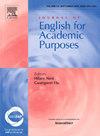Citations in post-methods sections of quantitative and qualitative research articles in second language learning: A corpus-based study
IF 3.4
1区 文学
Q1 EDUCATION & EDUCATIONAL RESEARCH
引用次数: 0
Abstract
Citation practices within the post-methods sections (i.e., results, discussion, implications, and conclusion) of research are crucial for knowledge generation, as they contribute to the interpretation, explanation, and evaluation of new findings in relation to previous literature. Despite their importance, these practices have remained underexplored. Addressing this gap, we conducted an in-depth analysis of a balanced sample comprising 96 quantitative and qualitative research articles on second language (L2) learning and teaching published in 2016, 2019, and 2022 in four top-tier journals. We examined the rhetorical functions and linguistic forms of citations within the post-methods sections, to explore (1) whether and how the post-methods sections revisit the literature used for framing a study in the literature review, (2) what rhetorical functions these post-methods citations fulfill, and (3) how they are linguistically realized. The results showed that (1) most of the literature cited in the literature review was not re-invoked in the post-methods sections, while half of the literature cited in the post-methods sections was newly introduced; (2) the rhetorical functions fulfilled by these post-methods citations in quantitative and qualitative research are overlapping yet distinct, and (3) their linguistic forms exhibit minor research paradigm differences. Implications for applied linguistics and EAP pedagogy and research are discussed.
基于语料库的第二语言学习定量与定性研究文章后方法部分引文分析
研究的后方法部分(即结果、讨论、含义和结论)的引用实践对于知识生成至关重要,因为它们有助于解释、解释和评估与先前文献相关的新发现。尽管它们很重要,但这些实践仍未得到充分探索。为了解决这一差距,我们对2016年、2019年和2022年在四家顶级期刊上发表的96篇关于第二语言(L2)学习和教学的定量和定性研究文章进行了深入分析。我们考察了后方法部分中引用的修辞功能和语言形式,以探索(1)后方法部分是否以及如何重新审视文献综述中用于构建研究的文献,(2)这些后方法引用实现了哪些修辞功能,以及(3)它们是如何在语言上实现的。结果表明:(1)文献综述中引用的文献大部分没有在后方法部分被重新引用,而后方法部分被引用的文献有一半是新引入的;(2)这些后方法引用在定量和定性研究中的修辞功能既有重叠又有区别;(3)它们的语言形式表现出较小的研究范式差异。讨论了对应用语言学和EAP教学法和研究的启示。
本文章由计算机程序翻译,如有差异,请以英文原文为准。
求助全文
约1分钟内获得全文
求助全文
来源期刊

Journal of English for Academic Purposes
Multiple-
CiteScore
6.60
自引率
13.30%
发文量
81
审稿时长
57 days
期刊介绍:
The Journal of English for Academic Purposes provides a forum for the dissemination of information and views which enables practitioners of and researchers in EAP to keep current with developments in their field and to contribute to its continued updating. JEAP publishes articles, book reviews, conference reports, and academic exchanges in the linguistic, sociolinguistic and psycholinguistic description of English as it occurs in the contexts of academic study and scholarly exchange itself.
 求助内容:
求助内容: 应助结果提醒方式:
应助结果提醒方式:


